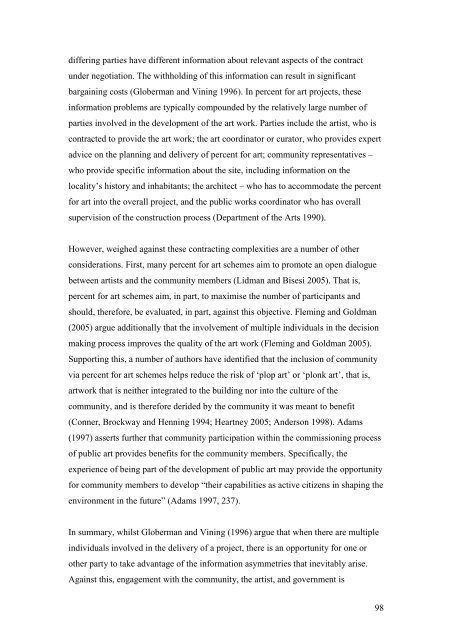Multi Outcome Construction Policy (final report)
Multi Outcome Construction Policy (final report)
Multi Outcome Construction Policy (final report)
You also want an ePaper? Increase the reach of your titles
YUMPU automatically turns print PDFs into web optimized ePapers that Google loves.
differing parties have different information about relevant aspects of the contractunder negotiation. The withholding of this information can result in significantbargaining costs (Globerman and Vining 1996). In percent for art projects, theseinformation problems are typically compounded by the relatively large number ofparties involved in the development of the art work. Parties include the artist, who iscontracted to provide the art work; the art coordinator or curator, who provides expertadvice on the planning and delivery of percent for art; community representatives –who provide specific information about the site, including information on thelocality’s history and inhabitants; the architect – who has to accommodate the percentfor art into the overall project, and the public works coordinator who has overallsupervision of the construction process (Department of the Arts 1990).However, weighed against these contracting complexities are a number of otherconsiderations. First, many percent for art schemes aim to promote an open dialoguebetween artists and the community members (Lidman and Bisesi 2005). That is,percent for art schemes aim, in part, to maximise the number of participants andshould, therefore, be evaluated, in part, against this objective. Fleming and Goldman(2005) argue additionally that the involvement of multiple individuals in the decisionmaking process improves the quality of the art work (Fleming and Goldman 2005).Supporting this, a number of authors have identified that the inclusion of communityvia percent for art schemes helps reduce the risk of ‘plop art’ or ‘plonk art’, that is,artwork that is neither integrated to the building nor into the culture of thecommunity, and is therefore derided by the community it was meant to benefit(Conner, Brockway and Henning 1994; Heartney 2005; Anderson 1998). Adams(1997) asserts further that community participation within the commissioning processof public art provides benefits for the community members. Specifically, theexperience of being part of the development of public art may provide the opportunityfor community members to develop “their capabilities as active citizens in shaping theenvironment in the future” (Adams 1997, 237).In summary, whilst Globerman and Vining (1996) argue that when there are multipleindividuals involved in the delivery of a project, there is an opportunity for one orother party to take advantage of the information asymmetries that inevitably arise.Against this, engagement with the community, the artist, and government is98
















